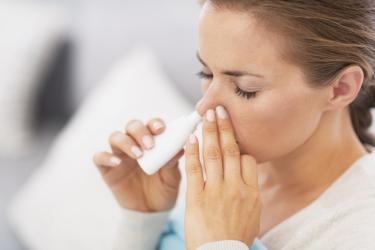Each year, as students head back to school and we approach the colder months, Centra sees an uptick in cold, flu, and RSV patients. Dr. Logan Haley, a medical resident with Centra Lynchburg Family Medicine Residency, provides tips on staying healthy throughout this season and offers advice on when to stay home from work or school and see a doctor.
As cold and flu season approaches, what are the most common viruses people catch?
Several viruses are commonly caught in the colder months, usually as early as September and until around March. This season is known for its respiratory viruses. It is also called "Flu Season" because people stay inside more and are more prone to spreading germs to one another, whether directly person-to-person or indirectly, through respiratory droplets on objects or in the air.
The three most common respiratory viruses spread in the colder months are the common cold, influenza, and RSV. Below is some information about each illness:
- The most common illness in this season is the common cold, caused by a vast family of viruses called "Rhinoviruses." The common cold is characterized by general feelings of illness, malaise, and fatigue and is often accompanied by symptoms of fever, chills, headache, sinus congestion, sneezing, runny nose, cough, and sore throat. If a fever is present, it is usually a lower-grade fever, typically defined as anywhere between 99.6 to 100.3 degrees Fahrenheit.
- The other common virus in this season is influenza, which is a virus that we sometimes don't take seriously enough because it has become so familiar to us. Influenza presents some of the same symptoms as the common cold but with a few additional GI symptoms. Commonly, the flu presents a fever above 100.4 degrees Fahrenheit and can even get as high as 106 degrees. The flu often presents upper respiratory symptoms such as congestion, cough, runny nose, headache, and sore throat. Still, GI symptoms such as nausea, vomiting, and diarrhea are also present. It is essential to consider that children who are regularly in daycare, college students who live in dorms, individuals residing in nursing homes, people who work in healthcare settings, or other people who live or work in close quarters with many other individuals are at increased risk for catching the flu.
- Lastly, one of the third most common viruses that spread during this season is called RSV, which stands for "Respiratory Syncytial Virus." This virus can mimic the common cold since it can present with the same symptoms, such as cough, congestion, chills, headaches, sneezing, and runny nose, but it can also be more severe in some cases. It infects both children and adults, but it can be most severe in infants and very young children as well as elderly and immunocompromised adults. The more severe cases of RSV can cause bronchiolitis, which is irritation and inflammation of the lower small airways in the lungs. This can lead to difficulty breathing and may even require hospital admission to maintain good oxygen levels in some cases. While older adults are indeed at increased risk for RSV, infants are most severely affected by RSV due to their relatively weak immune systems. Infants may present with short, shallow, and rapid breathing, which might cause the chest muscles and skin to pull inward with each breath. If you see an infant experiencing these severe symptoms, please bring them to the hospital for immediate evaluation and treatment.
When should children or employees stay home when feeling sick?
In general, if you have a fever of above 100.4 degrees Fahrenheit or any symptoms of being sick, you should stay away from others to prevent the spread of these common illnesses. Most importantly, if you know you are sick, don't push past it and go to work anyway because not only will you feel terrible and not work well, but you are risking spreading the illness to others. Staying home until you are asymptomatic and fever-free is the best practice to help reduce the spread of disease and allow yourself enough time to recover fully.
At what point is it recommended to see a doctor?
If you’re experiencing a fever of 100.4°F or higher despite regularly taking Tylenol or Motrin, it’s wise to seek a physician's evaluation. Similarly, any symptoms lasting longer than 10 days should prompt a visit to your doctor. This is especially important if you are immunocompromised or caring for a sick infant or young child. If you test positive for COVID-19 and have developed more severe symptoms within the last two days, consider asking your doctor about Paxlovid as a treatment option. Likewise, if you've tested for the flu and your symptoms have only lasted two days or less, inquire about Tamiflu. Persistent severe facial or sinus pain or a cough lasting 10 days or more after an upper respiratory infection may indicate a bacterial sinus infection or pneumonia, requiring medical evaluation. Over-the-counter tests are available for those worried about potential COVID-19, and testing can also be done at urgent care or your doctor’s office.
For symptoms of a common cold, a physician will likely recommend supportive care, including staying hydrated with plenty of fluids, eating as tolerated, taking pain relievers and fever reducers like Tylenol or Motrin every 4-6 hours, using decongestants like Mucinex and employing nasal saline rinses or a Neti Pot for congestion, all while ensuring adequate rest for recovery.
How can we help reduce the spread of infectious diseases?
The CDC has released a unified approach to help reduce the spread of respiratory viruses that address COVID-19, influenza, and RSV similarly because some things apply to all these diseases.
- First, good hand hygiene is crucial for preventing the spread of these viruses. Frequent hand washing and cleaning of public high-touch surfaces are vital for preventing transmission.
- Another essential prevention measure that can significantly reduce the overall number of cases is vaccination. Influenza, COVID-19, and RSV all have vaccines that are now readily available. These vaccines significantly increase the "herd immunity" in a community to decrease the number of overall cases, and vaccines significantly reduce the risk of getting the disease. Vaccines are especially recommended for groups with weaker immune systems, but they are also beneficial for the whole community in increasing herd immunity.
- Lastly, if you have been sick recently, wearing a mask while ill and for a few days after feeling better can help reduce the risk of transmission.



